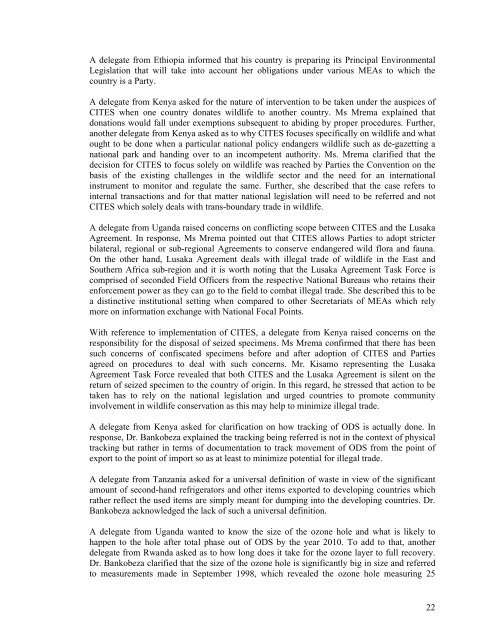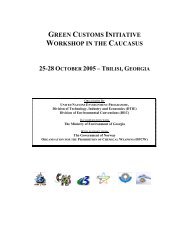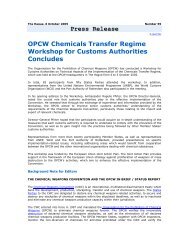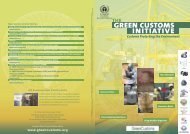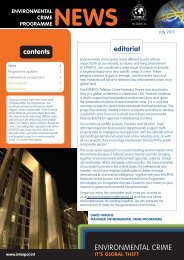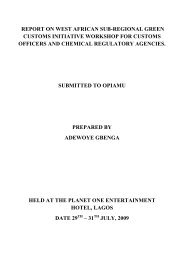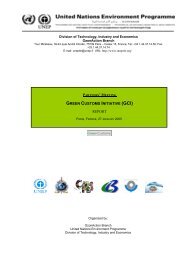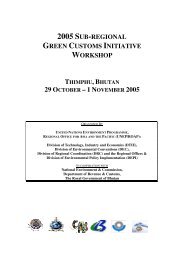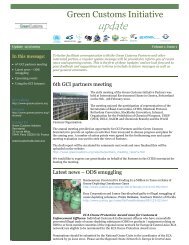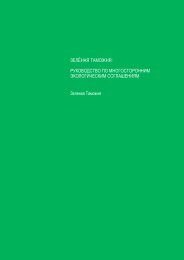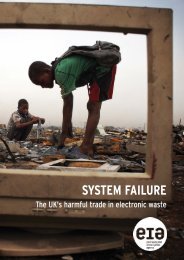Arusha - Green Customs Initiative
Arusha - Green Customs Initiative
Arusha - Green Customs Initiative
Create successful ePaper yourself
Turn your PDF publications into a flip-book with our unique Google optimized e-Paper software.
A delegate from Ethiopia informed that his country is preparing its Principal Environmental<br />
Legislation that will take into account her obligations under various MEAs to which the<br />
country is a Party.<br />
A delegate from Kenya asked for the nature of intervention to be taken under the auspices of<br />
CITES when one country donates wildlife to another country. Ms Mrema explained that<br />
donations would fall under exemptions subsequent to abiding by proper procedures. Further,<br />
another delegate from Kenya asked as to why CITES focuses specifically on wildlife and what<br />
ought to be done when a particular national policy endangers wildlife such as de-gazetting a<br />
national park and handing over to an incompetent authority. Ms. Mrema clarified that the<br />
decision for CITES to focus solely on wildlife was reached by Parties the Convention on the<br />
basis of the existing challenges in the wildlife sector and the need for an international<br />
instrument to monitor and regulate the same. Further, she described that the case refers to<br />
internal transactions and for that matter national legislation will need to be referred and not<br />
CITES which solely deals with trans-boundary trade in wildlife.<br />
A delegate from Uganda raised concerns on conflicting scope between CITES and the Lusaka<br />
Agreement. In response, Ms Mrema pointed out that CITES allows Parties to adopt stricter<br />
bilateral, regional or sub-regional Agreements to conserve endangered wild flora and fauna.<br />
On the other hand, Lusaka Agreement deals with illegal trade of wildlife in the East and<br />
Southern Africa sub-region and it is worth noting that the Lusaka Agreement Task Force is<br />
comprised of seconded Field Officers from the respective National Bureaus who retains their<br />
enforcement power as they can go to the field to combat illegal trade. She described this to be<br />
a distinctive institutional setting when compared to other Secretariats of MEAs which rely<br />
more on information exchange with National Focal Points.<br />
With reference to implementation of CITES, a delegate from Kenya raised concerns on the<br />
responsibility for the disposal of seized specimens. Ms Mrema confirmed that there has been<br />
such concerns of confiscated specimens before and after adoption of CITES and Parties<br />
agreed on procedures to deal with such concerns. Mr. Kisamo representing the Lusaka<br />
Agreement Task Force revealed that both CITES and the Lusaka Agreement is silent on the<br />
return of seized specimen to the country of origin. In this regard, he stressed that action to be<br />
taken has to rely on the national legislation and urged countries to promote community<br />
involvement in wildlife conservation as this may help to minimize illegal trade.<br />
A delegate from Kenya asked for clarification on how tracking of ODS is actually done. In<br />
response, Dr. Bankobeza explained the tracking being referred is not in the context of physical<br />
tracking but rather in terms of documentation to track movement of ODS from the point of<br />
export to the point of import so as at least to minimize potential for illegal trade.<br />
A delegate from Tanzania asked for a universal definition of waste in view of the significant<br />
amount of second-hand refrigerators and other items exported to developing countries which<br />
rather reflect the used items are simply meant for dumping into the developing countries. Dr.<br />
Bankobeza acknowledged the lack of such a universal definition.<br />
A delegate from Uganda wanted to know the size of the ozone hole and what is likely to<br />
happen to the hole after total phase out of ODS by the year 2010. To add to that, another<br />
delegate from Rwanda asked as to how long does it take for the ozone layer to full recovery.<br />
Dr. Bankobeza clarified that the size of the ozone hole is significantly big in size and referred<br />
to measurements made in September 1998, which revealed the ozone hole measuring 25<br />
22


